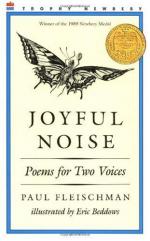
|
| Name: _________________________ | Period: ___________________ |
This test consists of 15 multiple choice questions and 5 short answer questions.
Multiple Choice Questions
1. According to this poem, why is the moth drawn to the light?
(a) It does not know why.
(b) It likes bright colors.
(c) It is attracted to the heat of the light.
(d) It likes the color yellow.
2. How does the poet help the reader relate to fireflies?
(a) He compares the fireflies to dancers.
(b) He compare the fireflies to athletes.
(c) He compares the fireflies to musicians.
(d) He compares the fireflies to artists.
3. "Water Striders" asks whether this insect's ability to walk on water is what?
(a) Fun.
(b) Useful.
(c) A miracle.
(d) Dangerous.
4. What is significant about the answer to number 38?
(a) It makes a firefly very similar to other species of insects.
(b) It makes a firefly very dangerous.
(c) It makes a firefly truly distinct among insects.
(d) It makes a firefly seem scary and strange.
5. What aspects of humanity can be learned from the book lice poem?
(a) How love affects lice.
(b) How compromise is needed in relationships.
(c) How to meet others.
(d) Why book lice eat books.
6. Who reads which part of this book?
(a) Each person takes turns reading a line.
(b) Each person takes turns reading a paragraph.
(c) One person reads the lines on the left, while the other person reads the lines on the right.
(d) One person reads the odd chapters, while the other person reads the even ones.
7. _______________ are used to help people to better understand the insect world around them.
(a) Animal instincts.
(b) Human emotion and perspective.
(c) Insect behavior.
(d) Scientific words.
8. What happened after the two book lice met?
(a) They fell in love.
(b) They got into a fight.
(c) They shared a book as a home.
(d) They tried to move to separate shelves.
9. The water strider's ability to walk on water hints at what?
(a) Jesus Christ's ability to change water into wine.
(b) The lack of talent other insects have.
(c) The strange abilities of some insects.
(d) Jesus Christ's ability to walk on water.
10. What are the homes of the lice?
(a) Encyclopedias.
(b) Books by famous authors.
(c) Children's heads.
(d) Fruits.
11. "Water Striders" describes the _________ action of this insect.
(a) Difficult.
(b) Simple.
(c) Detailed.
(d) Complicated.
12. How are these two book lice opposites?
(a) They are two different kinds of book lice.
(b) They have contrasting reading interests.
(c) They were born several months apart.
(d) They are from different rooms in the house.
13. How else do they spend their time?
(a) Attacking other insects.
(b) Raising their children.
(c) Swimming.
(d) Mating.
14. How do the letters that are the answer to number 54 have emphasis placed on them?
(a) By only using words that begin with these letters.
(b) By putting them in bold print.
(c) By using them repeatedly.
(d) By using them at the beginning of most of the lines.
15. "Grasshoppers" is written so that the readers do what?
(a) Speak slowly and quietly.
(b) Say the same thing.
(c) Say very different things.
(d) Speak very quickly and loudly.
Short Answer Questions
1. According to this poem, what else do the moth and the book lice have in common?
2. What does the vocabulary in "Grasshoppers" do for the readers?
3. "Grasshoppers" describes the grasshoppers' _______________ movements and energy.
4. What does this poem about book lice introduce to the reader?
5. What does the mayfly desire?
|
This section contains 603 words (approx. 3 pages at 300 words per page) |

|




